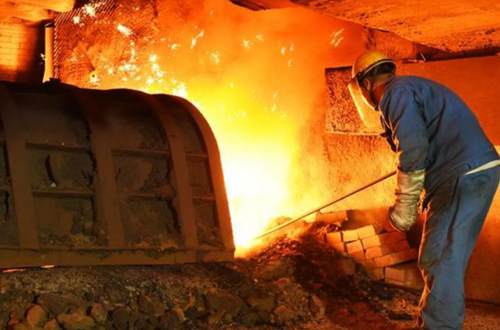
CPC can be used in steel production to produce carbon electrodes, both for induction and electric furnaces. The use of CPC in these processes balances the carbon content during the manufacturing process and helps in achieving desired mechanical properties, including electrical conductivity. CPC market is divided by end use into two segments: carburizing and recarburizing, as well as electric arc and induction furnaces. More than 80% - 85% market share is held by the electric induction and arc furnaces. It is due to an increase in carbon electrode consumption for production of steels with high strength and light alloys.
In order to produce CPC, raw petroleum coke is placed into a rotating kiln and heated at temperatures between 1200°C to 1350°C. These temperatures remove any excess moisture, extract all remaining hydrocarbons and modify the crystalline structure of the coke, converting it into a denser more electrically conductive product. After cooling, coke can be transported in silos, trucks, railcars or barges.
CPCs may require a certain grade, depending on the smelter's requirements. Aminco is attentive to the operating concerns of its customers and provides the best feedstock.

CPC smelting plants typically employ either SO2 scrubbing or oxidative desulphurization technologies to reduce SO2 emissions from the calcining process. Increasing environmental restrictions are driving more smelters to incorporate SO2 scrubbing at their calcining plants. Aminco provides its customers with a range of SO2 scrubber technologies that are tailored to their specific requirements. It also offers services in order to manage the process, and maximize the performance of the smelter.
Aminco conducts thorough tests to determine the CPC that is best suited for each smelter. In order to obtain the specific porosity profiles and bulk densities of the smelters, these test data are used. Aminco's ability to provide the correct calcined kiln coke in order to reduce coke net consumption and ensure consistent quality is enabled by this.
It is an energy-intensive and complex process to calcinate petroleum coke. Aminco created a CHP that utilizes the waste heat and byproducts from the calcining processes, as well as a waste gas purifier. This is a great way to reduce costs and improve coke-calcination. Diagram below illustrates the main components of the advanced system. The petroleum coke charger (black), electrothermal liquidized bed calciner, with electrodes (red), and nitrogen supply system (yellow gold) are all shown. It also includes the coke cooler and generator (blue-violet). This innovative technology is offered by Aminco in partnership with Superior Graphite Company. The partnership resulted from the commercialization GTI's innovative, highly efficient and proven CHP solution.

Write a Message